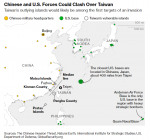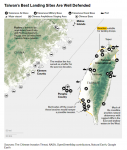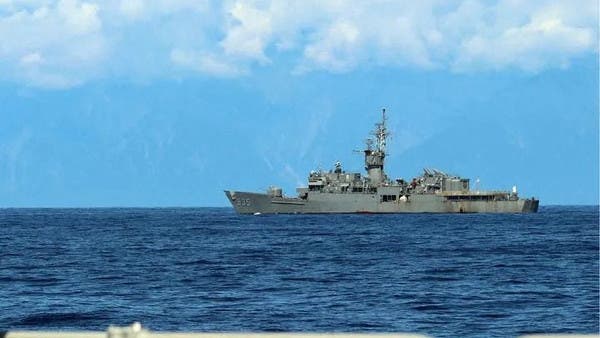danielboon
TB Fanatic
Update China cyber attacks on Taiwan infrastructure including train stations
View: https://mobile.twitter.com/EndGameWW3/status/1557083451588845578?cxt=HHwWlIC9mcjJ75srAAAA





So there are some simulations of a hypothetical war between the US and China over Taiwan where China wins.Julian Ku 古舉倫
@julianku
5h
“Probably the biggest [takeaway] is, under most assumptions, the United States and Taiwan can conduct a successful defense of the island. That’s different from many people’s impressions"...

War Game Finds U.S., Taiwan Can Defend Against a Chinese Invasion
A complex daylong war game, played out recently at a Washington think tank, demonstrated how destructive any attempted Chinese invasion of Taiwan would be across the Indo-Pacific.www.wsj.com
So there are some simulations of a hypothetical war between the US and China over Taiwan where China wins.
I would like to know what the assumptions are whereby China wins? It does seem to me that the war game is classified, so we may never know.
Well, if China wants to play chess, just attack the US warships passing thru the Strait and see what Uncle Joes does?
"Winning" is very often a lot more expensive than the MSRP would have you suspect....
They could lets hope notWell, if China wants to play chess, just attack the US warships passing thru the Strait and see what Uncle Joes does?
If Joe does nothing, then the invasion of Taiwan will begin!They could, lets hope not

There are those hypotheticals. I don't buy it. If I'm a General, I would project that I would lose every time in order to make my enemy more confident than they should be. It's a game. What is talked about is how China's navy has more ships than the US now. What is NOT talked about is that air superiority rules, and the US and NATO has double the fighter jets than Russia and China combined. This does not include allies such as Australia, Japan, India, and South Korea. It's total nonsense that China could establish air superiority in any action they take.So there are some simulations of a hypothetical war between the US and China over Taiwan where China wins.
I would like to know what the assumptions are whereby China wins? It does seem to me that the war game is classified, so we may never know.
So there are some simulations of a hypothetical war between the US and China over Taiwan where China wins.
I would like to know what the assumptions are whereby China wins? It does seem to me that the war game is classified, so we may never know.
If you can sink 2 US aircraft carriers and destroy 700 US/Japan aircraft, take 1/3rd of Taiwan, then with more effort you will win.This thread/article may answer some, if not all, of your questions. The article is beyond a pay wall for me, and I don't have time to collate/post the thread, but you can click below and read more if you're interested:
Zack Cooper
@ZackCooper
Good piece by
@wstrobel
@WSJ
on wargaming about Taiwan scenarios. I was on Team China with
@becca_wasser
- we sunk 2 US aircraft carriers and destroyed 700 US/Japan aircraft. But we still only took 1/3rd of Taiwan before our amphibs were sunk and our invasion petered out.
Every game is different but this one served as a reminder that in some ways an invasion of Taiwan is easier for us to defeat than: - Blockade - Missile bombardment - Outlying island seizure Thanks to Eric Heginbotham and
@MarkCancian
for including me.
This time is different, with Beijing breaking tacit cross-strait understandings and showing better planning of massive exercises meant to warn Taiwan, according to defense analysts.
From repeating advanced warnings, to the formal announcement and specific operations of the war games, the People’s Liberation Army wants to show the world that they are not only combat-ready for a Taiwan contingency, but also keeping all risks under control,” said Andrei Chang, editor-in-chief of Canada-based Kanwa Asian Defence…
The last time the PLA held missile tests aimed at Taiwan, all of the mainland’s warships stayed within the median line, and while a few warheads hit waters near Taipei and Kaohsiung, none of the missiles flew over the island.
Taipei-based military expert Chi Le-yi said the 1995-1996 tests covered the north and south of Taiwan to block its air and sea routes and were to verify the army’s “missile blockade tactics”.
However, this time, the PLA is going further to bring east Taiwan and the southwest Bashi Channel under its missile range coverage,” Chi said. “This is a clear move aimed at showing how they would block the entrance of vessels and aircraft from the US and Japan to Taiwan in the event of a contingency.

In an off-the-record discussion with Asia Times, one of the original members of the Richard Nixon delegation to China in 1972 stated that the Pelosi visit “clearly violates the spirit of the Shanghai Communique.” That stems from the Constitutional status of the Speaker of the House of Representatives.The Chinese side reaffirmed its position: the Taiwan question is the crucial question obstructing the normalization of relations between China and the United States; … Taiwan is a province of China … the liberation of Taiwan is China’s internal affair in which no other country has the right to interfere; and all US forces and military installations must be withdrawn from Taiwan.
The US side declared: The United States acknowledges that all Chinese on either side of the Taiwan Strait maintain there is but one China and that Taiwan is a part of China. The United States Government does not challenge that position. It reaffirms its interest in a peaceful settlement of the Taiwan question by the Chinese themselves.
Article 8 of the Anti-Secession Law to which Xie Maosong refers states:The United States and Taiwan’s Tsai Ing-Wen government took the initiative to break and change Taiwan’s status quo in substance. China was therefore forced to activate the anti-secession law [of 2005], and undertake the reunification process at any time of it is choosing. Whether that means reunification by force, or to advance reunification by [threat of] force, is up to China. There are complete and legitimate reasons for this.
Official Chinese media have made numerous references to the Anti-Secession Law during the past week, including a statement from the Standing Committee of the National People’s Congress reported by China Daily on August 2.In the event that the “Taiwan independence” secessionist forces should act under any name or by any means to cause the fact of Taiwan’s secession from China, or that major incidents entailing Taiwan’s secession from China should occur, or that possibilities for a peaceful reunification should be completely exhausted, the state shall employ non-peaceful means and other necessary measures to protect China’s sovereignty and territorial integrity.
Some of China’s leaders proposed to prevent Pelosi’s plane from reaching Taiwan, according to sources familiar with discussions in Beijing. The US military evidently considered that a serious possibility. As Pelosi’s aircraft turned north over the Philippines on its trip from Kuala Lumpur to Taipei, a second aircraft took off from Clark Air Force Base in the Philippines and trailed the Speaker’s plane.After then US President Trump launched a trade war with China in 2018, Kissinger believed that Sino-US relations would never return to the way they were before. This year marks the 50th anniversary of Nixon’s visit to China. As a special envoy in 1971, Kissinger was an advance man and icebreaker. At 10:43 p.m. on the 2nd, the moment Pelosi–the third most important political figure in the United States–landed at Taipei Songshan Airport, the status quo in Taiwan was unilaterally changed by the United States and the Taiwan authorities, and it will never return to what it was in the past.
Kissinger, as the icebreaker for Sino-US relations fifty years ago, has been invited by all US presidents since Nixon to meet at the White House and discuss his views on Sino-US relations … The sole exception is the current US President Joe Biden.
50 years ago, as well as 50 years later, the initiative came from the United States. This time the United States chose the opposite of what it chose in 1972. In both cases, America’s choice was subordinate to what the United States believed to be its own national interests. This is political realism in international relations.

 asiatimes.com
asiatimes.com

:quality(70)/cloudfront-us-east-1.images.arcpublishing.com/archetype/LF5RKZKEBRCBLHJBHSIE2WLL6A.jpg)
